In principle, the chainset is responsible for transmitting the energy from the motion of the pedals (manual pedaling) to driving the rear cycle wheel and hence the whole cycle forward. It achieves this transmission via the chain and cassette, and using gears to increase propulsion with optimum cadence. The chainset can be thought of as the hub of the geared cycle mechanical propulsion system (if we take the rider out of the equation).
A chainset consists of one, two or three toothed chain rings, the crank arms (the arms that the pedals are attached to), and occasionally (depending on chainset type), bottom bracket bearings. A two or three chain ring chainset have the chain rings bolted to each other. On entry level road bikes there are commonly five bolts on what is sometimes referred to as a five arm spider.
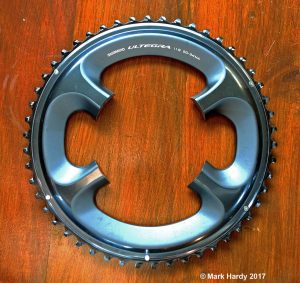
On higher quality road bikes four bolts are usual on a four arm spider. On mountain bikes and hybrids, there are usually four bolts. On a two or three chain ring chainset each chain ring has a different diameter and hence a greater or lesser number of teeth around its circumference. In general, if the chain is meshed with the teeth on the largest chain ring, pedaling is harder and requires more energy to achieve the required cadence. The opposite is true with the smallest diameter chain ring.
Use of chain ring with changing terrain.
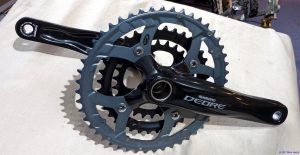
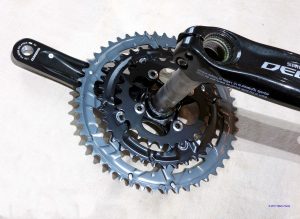
Let’s look at an example of how the chainset helps the rider to cycle. Let’s imagine a road bike with a chainset of two chain rings and a rear cassette with ten sprockets. Twenty gears in total. We will call the largest cassette sprocket first gear, and the smallest, tenth gear. The rider has the chain on the large chain ring and gear four on the cassette. She is pedaling along a flat level road. She wants to increase speed. She can achieve this by pedaling faster, or, more efficiently, by going up a gear or two on the cassette. She chooses gear six. This means the chain is shifted to the sprocket two steps down in diameter. The pedaling feels harder but by keeping her pedaling cadence the same, she is now traveling at a faster speed. Now she finds herself at the foot of a hill on the road. Going uphill feels much harder remaining in that gear, she needs to make it easier for herself. She can achieve this in two ways. One is to come down a gear or two at the back (cassette) so the chain moves to a larger sprocket, or, by shifting the chain on the chainset from the larger chain ring to the smaller. This latter action has a more obvious easing in pedaling difficulty, and means that in each gear (sprocket) on the cassette, it feels easier to pedal than it does if the chain is on the larger chain ring. Of course she is travelling much slower uphill but at least she is progressing up the hill and not forced to stop because it gets too hard.
Connection of chainring, crank arms and bottom bracket.
The chainset is attached to one other very important component, the bottom bracket. This is a precision bearing system situated inside the bottom of the bike frame where the seat tube, down tube and chain stay meet. One crank arm is attached to the bottom bracket axle with the chainring, and on the other (left hand side of the bike) is attached directly to the bottom bracket axle. The crank arms are positioned diametrically opposite to each other so that a continuous independent balanced revolutionary motion of the riders’ two legs and pedals can be achieved.
Variations of chainsets.
Chainsets with two or three chain rings are usually referred to as standard double, compact double or triples. A standard double is typically a 52/39t. This means fifty-two teeth on the larger chain ring and thirty-nine on the smaller. A common example of a compact double is a 50/36t. Those professional road cyclists or experienced amateurs with strong leg muscles may choose a standard double over a compact for flat road and gently undulating terrain. This is because faster top speeds are possible on the flat and downhill road sections with a 52t chain ring over a 50t. Those two extra teeth mean a slightly larger diameter chain ring. It also means its harder to pedal but you are rewarded with a faster top speed.
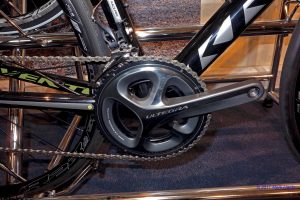
For most of us normal ability riders on road bikes, we prefer a compact double. The advantage is its easier to power up the hills. A 36t small chain ring means that in low gear we can make it to the top of the hill. Using a 39t, many of us would end up walking up hill pushing our bikes. On a few entry level road bikes, many hybrids and mountain bikes a triple is preferred. On rough terrain, or extreme uphill, we need the option of easy controlled pedalling at slow speeds. The small chain ring on a triple gives us that.
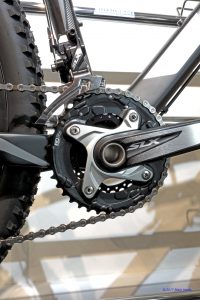
The teeth on the chain rings are of a thickness and profile that fit neatly into the gap in the chain links, and do not slip out of the links during revolution. It is therefore important that a chain is compatible with a particular chainset. Over time or with heavy use the profile of the teeth on the chain rings can change from abrasion. The familiar shark-tooth appearance of chain ring teeth is a sure sign that a new chainset is required. A new chain on a worn chain ring will likely slip.
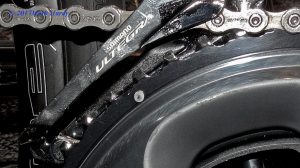
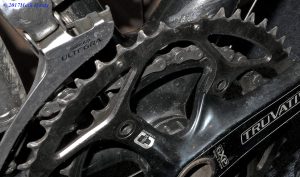

In recent years, some higher quality mountain bikes have been fitted with chainsets with only one chain ring, but with a large cassette at the rear. Such a system does not require the conventional front derailleur, the shifter or cable. Eleven gears on the cassette to choose from but there is a noticeably larger step between gears whilst pedaling. For professional and experienced amateurs this is not an issue. For them the missing chain rings, front derailleur, shifters and cable is missing weight. For us mere mortals, the smooth gear change of a triple or double chain ring, and the easier life a small front chain ring and large cassette sprocket offers us is usually what we prefer.